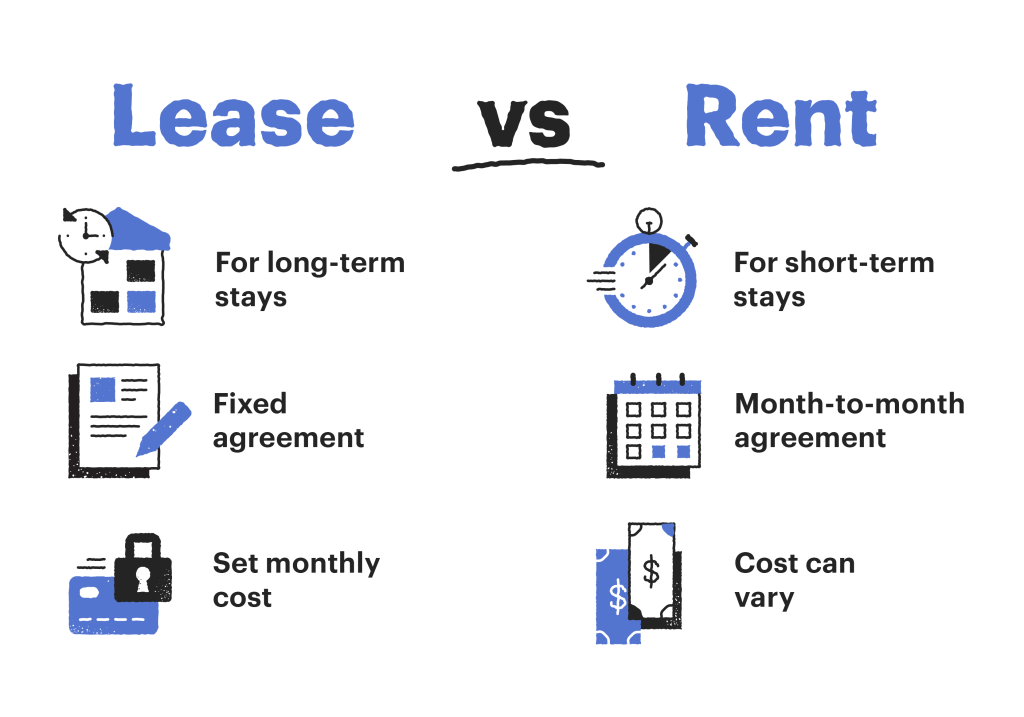Property ownership is a great way to build equity and accelerate your path to financial freedom.
While dealing with tenants, turnover, and repairs isn’t always easy, property management can be a lucrative and attainable gig for the average American.
In fact, about 7 in 10 landlords are average individuals who manage just one to four rental properties.
While large property managers can certainly hire lawyers to draft their lease and rental agreements, some of us little guys need more help understanding the difference between the two contracts and what details to include in them.
So, what exactly are lease agreements and how are they different from rental agreements? How do you know which one to use in a given situation?
Lease agreement vs. rental agreement

Lease agreements are long-term contracts entered into between the landlord and their tenants. These agreements typically span 6 to 12 months in length, though an 18-month lease isn’t unheard of.
Rental agreements, on the other hand, are short-term in nature. These contracts are usually binding for 30 days.
Once the time period is up, a new rental agreement is drafted and signed. Usually, the terms of the rental agreement will change from month to month.
Although they cover different time periods, lease and rental agreements have a lot of commonalities. First, these agreements will require a prospective tenant to provide collateral such as a security deposit and proof of renter’s insurance.
Both of these are very important when renting out your property because you’ll want to be protected from bearing the financial cost of any damage to the rental property while your tenant is renting from you.
The main difference between a lease and rental agreement is the time period. Plus, rental agreements will likely need to be renegotiated after every 30-day period, while lease agreements will stay consistent over the long-term period listed in the lease.
You may adjust provisions of your lease agreement after tenants move out, but ideally, these revisions shouldn’t take place more than once or twice a year. Both lease and rental agreements are necessary to keep you protected as the property owner. You don’t want your tenants to have free reign to do whatever they wish at your property.
Lease and rental agreements set the terms for conduct allowed in the rental unit and the manner in which you, as the landlord, will be compensated for providing the tenant a place to live.
Now, how do you know what type of agreement is right for you?
Pros and cons of a lease agreement
One perk of issuing a lease agreement is that you’ll likely have fewer tenants to manage.
Imagine renting your property out to one individual over a 12-month period versus potentially 12 different individuals for a 30-day period over the course of a year.
The nature of the lease agreement contract is long-term, and you’ll therefore manage fewer tenants. Plus, lease agreements minimize the administrative burden of advertising and showing your rental property as compared to rental agreements.
In addition, you may even find a few good tenants that wish to rent your property for a few years.
If you find the right long-term tenants, they can make your life much easier as a landlord because you’ll establish a dependable, trusting relationship with them, as opposed to the constant turnover and potential for an empty unit that can be associated with a rental agreement.
Now, lease agreements do have their setbacks. First, you won’t be able to change the rental price or other provisions of the lease agreement unless you get explicit written consent from your tenant.
As you can imagine, tenants aren’t exactly thrilled about rent hikes, and it is unlikely you’ll be able to change the price of rent while the lease agreement is still in place.
The key difference to note here is that lease agreements are more static than rental agreements, which can be much more flexible.
Landlords need to wait until the lease agreement period, which can range from 6 to 18 months, is complete before changing anything in the lease.
Lease agreements may be the right choice for you, as a landlord, if you want to manage a small number of tenants and you don’t mind having a long-term contract.
Although there are many types of lease agreements to choose from, PandaDoc’s lease agreement template is a cut above the rest because it makes drafting a lease agreement quick and painless. All you need to do is plug in your information and you’ve got a robust, detailed lease agreement ready for signing.
If the lease agreement doesn’t sound like your style, you may be better suited for a rental agreement.
Pros and cons of a rental agreement
In a nutshell, rental agreements are usually 30 days in length and provide property owners with more flexibility than lease agreements.
Landlords can change the price of rent as well as other rental agreement terms on a month-to-month basis. This could benefit you, as a landlord, if you’ve got a hands-on approach to property rentals. Plus, you’ll be able to maximize the return on your rental investment by keeping your pricing competitive with other rentals in your area.
But remember, with a high reward, there is usually a high risk. Be prepared to manage several tenants if you want to rent your property on a month-to-month basis.
As probability would have it, the more tenants you host, the more likely it is for problems to arise. In addition, you’ll need to stay on top of multiple, changing contracts and handle rotating tenant contact information.
If your tenant decides not to renew for another 30 days, you’ll need to start advertising your rental space quickly if you want to generate income from the rental property, or risk facing an empty unit until you manage to find a tenant.
Rental agreements may be ideal for the landlord who can easily manage the administrative burden of rotating tenants. These contracts would also work well for those living in prime working or vacation locations.
As remote work and the gig economy become even more commonplace in the American working environment, workers may regularly seek comfortable and flexible rental options to perform their work-from-home duties.
If the rental agreement seems more up your alley, consider PandaDoc’s rental agreement template. This is a great resource for those looking for an easy-to-use template that ensures their equity and needs are protected.
Although the nature of rental and lease agreements can differ, they share more similarities than you may guess.
Details to include in your lease and rental agreements
Regardless of which type of agreement you choose, you’ll want to cover several pertinent components in the contract. Let’s start with the essentials.
List the basics
In your lease and rental agreements, be sure to include the following basic information:
- Landlord name and contact information
- Tenant name and contact information
- Address of the rental property
- Length of the agreement
- Price of rent
- Method of rent payment
- Rental due date
- Required deposits (i.e. security or pet deposits)
- The number of tenants allowed to dwell at the property at one time
- Which party is responsible for utilities
- Renter’s insurance provisions
- General maintenance and upkeep guidelines
- When and how the landlord may access the rental property
- Tenant parking
These details essentially create the structure of your rental or lease agreement. Although, you may need to dig a little deeper and outline other specifics depending on your rental property and your wishes as a landlord.
Here’s what you should include if you want a more detailed agreement.
Other important details
Not everything is black and white, which is why you may need to tailor your lease or rental agreement to fit your unique needs as a landlord.
Here are a few examples of components you should consider drafting in your lease or rental agreement.
Pet policy
A pet policy is an important provision for any lease or rental agreement because it determines what kinds of animals, if any, will be allowed at the rental property.
When drafting your pet policy, be sure to include details such as what kinds of pets are permitted, the price of pet rent, as well as the amount the tenant should pay for the pet security deposit.
Even if your prospective tenant doesn’t have a pet currently, it’s a good idea to include a pet policy within the lease or rental agreement in case your tenant chooses to have a pet in the future.
Sublease provisions
Sometimes, tenants need to move unexpectedly before the lease or rental agreement period is complete.
In this scenario, your tenant may find someone to sublease the rental unit. You should explicitly detail the subleasing terms and qualifications in your rental or lease agreement.
These qualifications should include how much monthly income the subletter earns, criminal background checks, and landlord pre-approval before the sublease commences. This information is necessary so you know who is living in your rental unit at all times.
Terms for visitors
As a landlord, you wouldn’t want additional individuals staying at your rental property without your consent. For this reason, you should specify visitor terms in your lease or rental agreement.
As an example, you could require that visitors are only permitted to stay at the rental property for three consecutive days before needing landlord approval. Otherwise, you may have unexpected, unapproved tenants staying in your rental unit.
Damages to the rental property
Life happens, as do damages to the rental unit. If you don’t want to be on the hook for paying for tenant-induced rental property damage, provide specific language on damages in your rental or lease agreement.
This language should adequately describe what is considered damage and how the tenant should compensate you for any damage that occurs at the rental property.
You may want to explain the difference between normal wear and tear and serious damage. Normal wear and tear are considered damages to the property that naturally occur over time, such as small scuffs on countertops or floors.
Holes in the wall or severe damage to carpet, however, would be considered actual damage that the renter should compensate the landlord for.
Conduct prohibited at the rental property
Landlords may wish to explicitly state what conduct is not allowed within the rental unit in the lease or rental agreement.
For example, some property owners want to prohibit smoking inside the rental property, as this can cause unpleasant odors and nasty appearance damage to your property that persists long after the tenants have moved out.
If you’re renting out a property with a Home Owner’s Association (HOA), for instance, you’ll definitely want to include HOA requirements in the lease or rental agreement.
Otherwise, the HOA may fine you for conduct that violates the HOA agreement.
Provisions to include in the rental or lease agreement include details about keeping the outdoor or patio area neat and tidy, trimming the lawn to the desired HOA length, and keeping the rental property clear of any unsightly items such as excessive garbage or inoperable motor vehicles.
Furthermore, it’s always a good idea to include a clause that states illegal conduct of any kind is not allowed at the rental property, just to cover all of your bases.
Now, perhaps you aren’t quite ready for all the responsibility that comes with lease and rental agreements. What then?
Flexible options for short-term renting
If you’re considering earning income from your property but aren’t ready to rent out your space for 30 days or more, consider options such as Airbnb and Vrbo.
These companies allow private individuals to rent out their homes to those looking for accommodations in the local area. Hosts can set the pricing of their rentals, house rules, and which days they prefer to rent out their property.
Even better, both Airbnb and Vrbo will list your rental unit on their website, eliminating the need for advertising or marketing your rental property.
You may wonder, is it safe to rent on Airbnb and Vrbo?
Absolutely. Both platforms hold renters accountable for their community policies. What’s more, the services offer up to $1 million in liability insurance coverage on every property each year without an additional cost to the host.
With Airbnb and Vrbo, you can charge much more per night than you would earn with a lease or rental agreement. You may even be able to cover your rental property mortgage payment after just a handful of stays.
However, it is important to remember that this income may not always be steady. Airbnb and Vrbo rentals can be sporadic, meaning you may or may not be able to depend on a stable amount of income each month.
Generally, if your rental property is located in a prime location for vacationing and large-scale events, you’ll have an easier time renting out your property and keeping a steady rental income.
Short-term renting on Airbnb and Vrbo would be ideal for those looking to make some passive income without going through the trouble of finalizing a rental or lease agreement.
Stay in compliance with the law
Regardless of which property rental style you choose, as a landlord, you’ll need to stay in compliance with state and local laws. Depending on your area, you may be subject to different legal requirements when renting out your property.
These could include disclosures about the rental property itself, such as the presence of asbestos and mold. You may need to provide information about registered sex offenders who live in the area.
In addition, the state where your rental property is located may have rent control laws. Rent control is legislation that limits the price of rent in a city or state.
Specifically, California, New York, New Jersey, Maryland, Oregon, and the District of Columbia all have some sort of rent control laws.
Therefore, you’ll want to review relevant rent control language to ensure you aren’t illegally overcharging your tenants for rent.
And, of course, there are always the dreaded evictions.
These instances occur when you need to force your tenant to leave due to failure to pay rent or other lease or rental agreement violations.
First and foremost, you always have to give your tenant proper notice that eviction is forthcoming. From there, the city or state laws where your rental unit is located will likely dictate the next steps.
It’s always a good rule of thumb to not force your tenant out early or do anything with their property, as this is usually a punishable, illegal offense no matter what state you’re located in.
Include an eviction section in your lease or rental agreement so your prospective tenant understands this process.
Always be sure to review local, state, and federal laws before starting your journey as a landlord. If your vision is to manage a high volume of rental properties, consider finding a local attorney in your area to have on file in case issues arise.
Start your own lease or rental agreement today
Becoming a landlord is a great way to build equity and earn income. Depending on your lifestyle, you may decide that a lease agreement is the right rental contract for you.
On the other hand, you may opt for shorter-term options, such as rental agreements, Airbnb, or Vrbo.
No matter which path you choose, PandaDoc has you covered. PandaDoc has quick and easy lease agreement and rental agreement templates to get your journey to becoming a landlord started.
Check out PandaDoc’s easy-to-use resources today to get one step closer to financial freedom.

